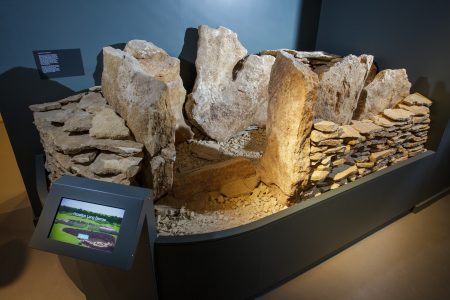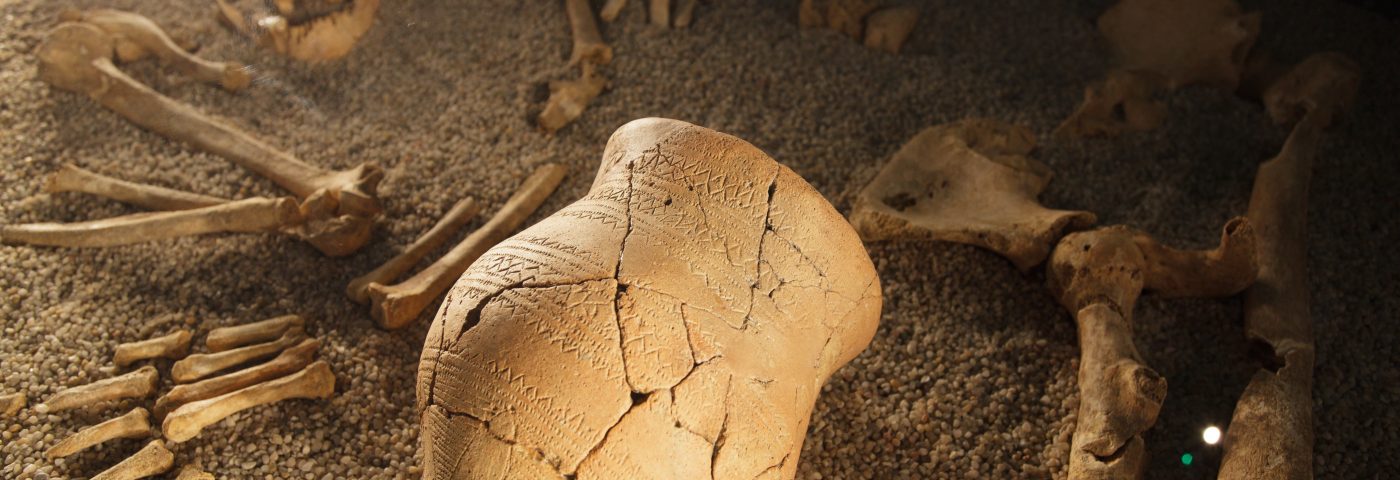Can the past hold the key to a better kind of burial?
Blog post by Samantha Fryer Ward
Apparently, modern-day Britons are turning to their prehistoric ancestors when looking for a more sustainable burial.
According to The i Paper on June 5th, modern barrows are being built around the country, and demand for megalithic-style burials is soaring.1
The first such modern burial mound was built over the county border near Stonehenge in Wiltshire. This Long Barrow at All Cannings has 1,000 urn slots, which were all taken within two years. There are now about a dozen barrows either built or going through the process of getting permission.
But burial chambers with shelving and neat urn slots do not truly reflect the prehistoric burial mounds, as is evidenced in the new Stone Age Galleries at the Corinium Museum. The exhibit on the Hazleton North Long Barrow, which was built around 5,000 years ago, explains that it contained some 9,000 bone fragments from 41 individuals. Only some bodies were found with complete skeletons in certain passageways and entrances. There is evidence that the other bodies were broken up and moved around. Not all the bodies were buried there at the same time.

So how did these people view death and the afterlife? Once the body was in skeletal form, did it lose its relevance as a connection to a particular individual and instead became part of the collective memorial to the dead? Would the complete skeletons have been moved and broken up to make way for new bodies if the barrow had continued in use?
An article about the dating of the Hazleton Long Barrow, in the Cambridge Archaeological Journal in 2007, says that there is one archaeological interpretation that suggests “the possibility that some of the human remains (those where the deposition of intact corpses cannot be strongly inferred from the archaeological record) may have been curated for a considerable time since death when deposited in the tomb.”2
Would there have been a specific job of a bone curator or a bone librarian, whose role involved moving bodies, and sorting and storing bones to make way for the new? Would they have understood all the nuances of family and tribal relationships through the time the barrow was in use, so they knew exactly whose remains should be moved where and to be with whom?
Also exhibited in the Stone Age Galleries at the Corinium Museum is the individual grave of a woman found at Kingshill North. She was buried around 2,400 to 2,100 BC and her grave is significant because it was a Beaker burial. The Beaker people were buried lying on their side with a decorated pot or beaker next to them in a circular tomb.

There are very few Beaker burials in the Cotswolds, only three female burials have been discovered, compared to some 70 Neolithic Long Barrows in Gloucestershire alone. Indeed, when isotope analysis was performed on the skeleton, she was found to have spent her childhood in the southern chalklands of England, not the Cotswolds at all. Was she travelling through the area when she died? Were her people on route to somewhere else? She was buried covered with a cow hide and with a finely decorated beaker, so perhaps she was a tribal leader.
As is obvious from the huge wealth of artefacts and information in the Corinium Museum, we know much about the lives, culture and religion of people in the Roman era. We can also learn much from their written records. The lives of rich Romans who died are often detailed on their gravestones, giving us even more knowledge and understanding.
But there is only so much that historians can tell about the past when there is little or no written history. Archaeologists can help us to understand more about ancient people by looking at remains (human and structural), burials and grave goods, and other artefacts, but there are still many questions left unanswered.
So, what is it that draws people today to opt for a prehistoric-style burial? What is it that resonates through the huge passage of time? Why does it appeal to those wanting a more sustainable burial? Is it that it feels closer to nature than a graveyard? Is it a more permanent memorial than scattering ashes in nature itself? Or maybe we are looking for a deeper connection with our ancestors in death and with the ancient mounds that rise up across our hills and fields.
Dr Kenny Brophy, an archaeologist at the University of Glasgow who is leading the Death BC project set up to study the modern burial mound phenomenon, told The i Paper: “It gives a sense of security. Burials are quite vulnerable to the processes of erosion and time and so on, and we know that megalithic monuments stand for 5,000 years. There’s very few things that we build now that last for 5,000 years.”1
So, in 5,000 years’ time what will archaeologists, if there are any then, understand about our culture from these modern megalithic barrows? Will our written records help to decode the past for our descendants or will shelving filled with urns raise more questions than they answer?
1 https://inews.co.uk/news/uk/rest-prehistoric-peace-rising-popularity-burial-mound-1035299










